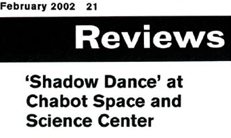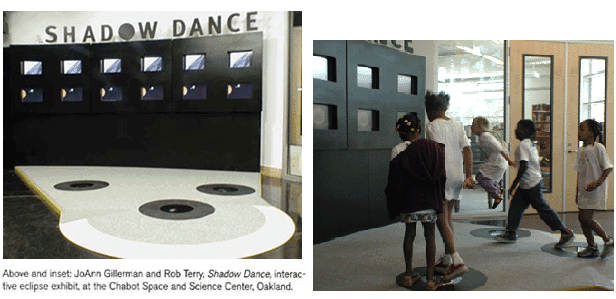|

Do
you know what an eclipse is? It's the exact alignment of the sun,
moon and earth. Captivating as this simple fact is, the multisensory
experience of this alignment is even more wondrous. Shadow Dance,
the newest exhibit at Chabot Space and Science Center atop the beautiful
hills of Oakland, offers you a glimmer of that awesome human experience
of nature's rhythms. The collaborative work, designed and produced
by local artists JoAnn Gillerman and Rob Terry, is a state-of-the-art
installation that morphs art and science. There is no mouse or keyboard.
You and your homies directly interact via a multi-channel, twelve-monitor
computer program by walking, dancing or rolling your wheelchair
around on three floor sensors. The sensors, attractively embellished
by backlit images of sun, moon and earth, enliven the installation's
stage. Your personal choreography re-creates eclipses (solar and
lunar) on the monitors, simultaneously evoking individualized mixes
of aural and visual imagery. Anyone with a sense of play will be
delighted by this mode of acquiring knowledge. This is "community-based"
art at its best.
Not only is Shadow Dance informative and pleasurable,
its special allure also rests on the uniqueness of its subject.
Wendy Coones, exhibits specialist at Chabot and an artist herself,
points out that early in the planning Chabot realized that "eclipses"
due to their very nature, would need to be represented from various
perspectives that include (even highlight) the aesthetic view. Mike
Reynolds, Chabot's executive director who chanced to meet Gillerman
and Terry at several such planetary events, had the insight that
a collaboration to celebrate their mutual interest was called for.

You'll have the opportunity to walk virtually the full
length of the impressive, newly renovated Chabot Center and across
the new "skybridge" to arrive at Shadow Dance. Its poetically
backlit floor images lure you as the sharp realism of the images
of its flat-screen monitors beckon you closer. The scale of this
installation is, quite wisely, human and unintimidating. You begin
to create a rhythm that suits you to access visual and aural information.
By figuring out the alignment of celestial bodies-or by chance-your
physical motion creates a simulated eclipse. Your visual attention
alternates between the complex imagery of the lower six monitors
and video footage of the various total solar and lunar eclipses
projected in the higher register of rectangular frames.
A banquet for the senses is served up; the combination
of delectables is your pick. And it can change during each visit.
Shadow Dance participants can choose to privilege the artist's viewpoint
presented in photographic, video or digitally treated visuals. Or
you could focus your attention on listening to recorded anecdotal
accounts of eclipse enthusiasts, explanations of the phenomena presented
by experts from the scientific community, or seductive narrations
of stories recounting poetic myths conjured up by nonwestern cultures
to celebrate their experiences.
My favorite among the latter is that of the Olmec peoples
of Central America for lunar eclipses. For these Americans, a powerful,
sky-abiding jaguar attacks the moon from time to time. Their gods
and goddesses were compassionate, and, rather than leave folks in
the dark, escorted the moon back to her sky and rekindled her each
time. The beauty here, to me, is that the Olniecs thoroughly understood
the science of lunar eclipses. They could even predict them. Yet
they sense no inherent conflict between the poetic account and the
scientific one. They were two equally valued modes of awareness
of the same natural phenomena. Shadow Dance's melding of scientific
and artistic evocation suggests a reinstatement of that combined
and, thereby, expanded perception.
What also sets Shadow Dance apart is its selected context.
Most spaces that display installations with aesthetic aspects -museums
or galleries (even contemporary ones)- prescribe your role as a
relatively passive observer. Here at Chabot you are envisioned as
a participant. The new installation, Shadow Dance, is successful
not only because it lures you to collaborate (to work to gain knowledge)
with artists and scientists but even more so because it virtually
"shows you the door." The wondrous images and astounding
personal accounts encourage you to get back outside in nature and
experience this and other cosmic phenomena firsthand. By enacting
the re-creation of this theatrical view of cosmic magnetism, you
are instilled by a new -or renewed- respect, reverence and awe.
This response to nature is more than appropriate, it is necessary
at this particular historical juncture. -Celeste
Connor
Shadow
Dance: The Interactive Eclipse Exhibit by JoAnn Gillerman and Rob
Terry is on permanent exhibit at the Chabot Space and Science Center,
10902 Skyline Blvd, Oakland.
Celeste
Connor is a freelance writer based in the East Bay.
|
|